This article needs additional citations for verification .(September 2015) |
There are three palaces in Seri Menanti, the royal capital of Negeri Sembilan, Malaysia.
Contents
- Istana Besar
- Istana Lama
- Istana Tasik
This article needs additional citations for verification .(September 2015) |
There are three palaces in Seri Menanti, the royal capital of Negeri Sembilan, Malaysia.

The Istana Besar, is the primary palace of the Yang Di-Pertuan Besar of Negeri Sembilan. It was built and completed in 1932, and officiated by Tuanku Muhammad ibni Almarhum Tuanku Antah who moved there after it was completed. The Istana Besar complex has extensive facilities to support the residence of the Yang Di-Pertuan Besar. In the main building, there is a grand hall, waiting and audience rooms, residential apartments spread over three floors. In the adjacent building, there is a throne room (Balairung Seri) where formal ceremonies are held which includes investitures, oath of allegiance / appointment ceremonies and where large congregational prayers are held. The main Banquet Hall, which was constructed almost seventy years later, can house approximately two thousand people. The current Yang Di-Pertuan Besar is Tuanku Muhriz.
There are also offices, facilities and general quarters for palace officials and staff.


The Istana Lama Seri Menanti, is one of the famous landmarks in Kuala Pilah District, Negeri Sembilan, Malaysia is made in part of chengal (Penak) wood ( Neobalanocarpus ) and iron wood or belian wood ( Eusideroxylon zwageri ) and held together using only wooden pegs. The palace took six years to build and was completed in 1908 at a cost of $45,000.00 at that time. The design has subtle hints of Minangkabau architecture, has five levels rising to a height of sixty seven feet or approximately twenty meters high and has ninety nine columns to support the main structure. Four of the main columns of sixty seven feet are the Chengal timber that came from Bukit Pergai, Jelebu and is the central feature of the structure which holds up the apex of the palace, namely the Treasury Room. The Istana Lama was a replacement for Istana Pulih which was burned down by British soldiers. The drawings and plans for Istana Lama was detailed by Mr. Woodford (Public Works Department) based on the designs provided by two local craftsmen, Kahar and Taib. This palace was used until 1932 after which the Yang Di-Pertuan Besar moved to Istana Besar.
The significance of the ninety nine columns is meant to represent the ninety nine officers of the palace (Hulubalang), while the four columns at the center is signify the four senior officials of the palace (Orang Empat Istana). The design of Istana Lama was expected to represent the ideals of familyhood, education, heritage and culture, and the historical bond with the Minangkabau kingdom of Pagaruyung.
Istana Lama was used as a religious school between 1959 and 1964, and was unoccupied until 1992. The Istana Lama has been designated as a national heritage site and was converted into a Royal Museum on July 14 1992, with the consent of and officiated by Tuanku Ja'afar the Yang Di-Pertuan Besar at the time. It is currently closed to the public to facilitate repairs and upgrading works which is expected to be completed in 2020. [1] [2] [3]
The palace has been assigned as building number 115 by the JKR. [4]
Istana Tasik or Lake Palace is located at the entrance to Istana Besar on the left, next to a small lake. It is quite small, has basic amenities and is used occasionally when required.
In February 2009, the Unity, Culture, Arts and Heritage Minister Datuk Seri Shafie Apdal announced that the Istana Lama is among ten historical structures in Malaysia gazetted as a national heritage, along with Victoria Institution in Kuala Lumpur and The Stadthuys in Malacca. [5]

Negeri Sembilan is a state in Malaysia which lies on the western coast of Peninsular Malaysia. It borders Selangor on the north, Pahang in the east, and Malacca and Johor to the south.
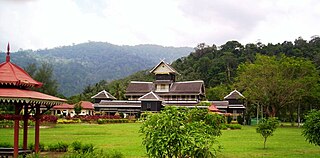
Seri Menanti is a town, a mukim and a state assembly constituency in Kuala Pilah District, in central Negeri Sembilan, Malaysia, located 33 km northeast of the state capital city of Seremban and 14 km southwest of Kuala Pilah. It is the royal capital of the state of Negeri Sembilan and houses the seat of the Yang Di-Pertuan Besar of Negeri Sembilan or Yamtuan Besar, the ruler of the state of Negeri Sembilan. The royal palace is known as "Istana Besar". Seri Menanti also governs the surrounding chiefdoms of Terachi, Gunung Pasir, Ulu Muar, Jempol and Inas, of which they are collectively known as Luak Tanah Mengandung.

Tuanku Sir Abdul Rahman ibni Almarhum Tuanku Muhammad was the first Paramount Ruler or Yang di-Pertuan Agong of the Federation of Malaya, eighth Yang di-Pertuan Besar of Seri Menanti and second Yang di-Pertuan Besar of modern Negeri Sembilan.
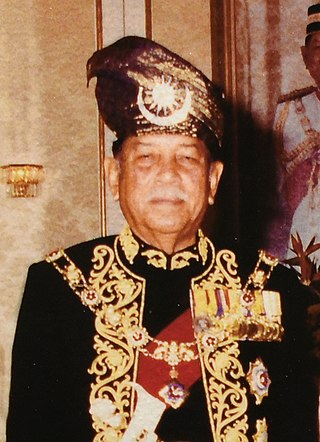
Tuanku Ja’afar ibni Almarhum Tuanku Abdul Rahman was the tenth Yang di-Pertuan Agong (King) of Malaysia from 26 April 1994 until 25 April 1999 and the tenth Yang Di-Pertuan Besar (Ruler) of Negeri Sembilan.
Tunku Puan Besar Hajah Kurshiah binti Almarhum Tunku Besar Burhanuddin was the Tunku Ampuan Besar or Queen of Negeri Sembilan. She also served as the first Raja Permaisuri Agong of Malaya between 1957 and 1960.

Sultanah Hajah Bahiyah binti Almarhum Tuanku Abdul Rahman was the Sultanah of Malaysian State of Kedah from 1959 until her death in 2003 and served as the fifth Raja Permaisuri Agong of Malaysia from 21 September 1970 until 20 September 1975.

The Kuala Pilah District is a district in central Negeri Sembilan, Malaysia. Its seat is the town of Kuala Pilah.
This article lists important figures and events in Malayan public affairs during the year 1960, together with births and deaths of significant Malayans.

Johol is a town, a mukim and a state assembly constituency in Kuala Pilah District, Negeri Sembilan, Malaysia. It is roughly halfway between Tampin and Kuala Pilah, along Federal Route 9.

Yamtuan, also known officially as Yang di-Pertuan Besar and unofficially as Grand Ruler, is the royal title of the ruler of the Malaysian state of Negeri Sembilan. The Grand Ruler of Negeri Sembilan is elected by a council of ruling chiefs in the state, or the Undangs. This royal practice has been followed since 1773. The Yamtuan Besar is elected from among the four leading princes of Negeri Sembilan ; the Undangs themselves cannot stand for election and their choice of a ruler is limited to a male Muslim who is Malay and also a "lawfully begotten descendant of Raja Radin ibni Raja Lenggang", the 4th Yamtuan.
Seri Menanti Royal Mausoleum is a Negeri Sembilan royal mausoleum located in the royal town of Seri Menanti, Kuala Pilah District, Negeri Sembilan, Malaysia. This mausoleum is located next to the Tuanku Munawir Royal Mosque.

Tuanku Sir Muhammad Shah ibni Almarhum Tuanku Antah was the seventh Yamtuan Besar of Seri Menanti, who ruled from 1888 to 1933. During his reign, Negeri Sembilan came under British protection in 1889 and became a Federated Malay State in 1895.
Tunku Laksamana Nasir Alam ibni Tuanku Muhammad Shah died in Seri Menanti, Negeri Sembilan, Malaysia in 1976. He is one of the sons of Tuanku Muhammad Shah. He was a member of the Negeri Sembilan royal family and is interred in Seri Menanti Royal Mausoleum. He served as Regent of Negeri Sembilan from 2 September 1957 to 1 April 1960, whilst his brother served his term as Yang di-Pertuan Agong of Malaya.
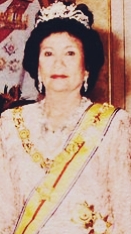
Tunku Ampuan Najihah binti Almarhum Tunku Besar Burhanuddin is the Tunku Ampuan of Negeri Sembilan. She was formerly the Tunku Ampuan Besar or Queen of Negeri Sembilan from 1967 to 2008. She also served as Raja Permaisuri Agong of Malaysia between 1994 and 1999.
Tuanku Aishah Rohani binti Almarhum Tengku Besar Mahmud is the current Tunku Ampuan Besar or Queen consort of Negeri Sembilan. She is married to the current Yang di-Pertuan Besar of Negeri Sembilan, Tuanku Muhriz ibni Almarhum Tuanku Munawir.
Tunku Zain Al-'Abidin ibni Tuanku Muhriz, more popularly known as Tunku 'Abidin Muhriz, is the second son of the reigning Yang di-Pertuan Besar of Negeri Sembilan in Malaysia, Tuanku Muhriz ibni Almarhum Tuanku Munawir and the reigning Tunku Ampuan Besar of Negeri Sembilan, Tuanku Aishah Rohani binti Tengku Besar Mahmud. He is the Founding President of the Institute for Democracy and Economic Affairs (IDEAS), Malaysia and is a trustee of Yayasan Chow Kit along with Yayasan Munarah.
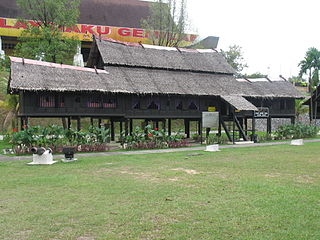
The Istana Ampang Tinggi was a royal residence in Negeri Sembilan in Malaysia.
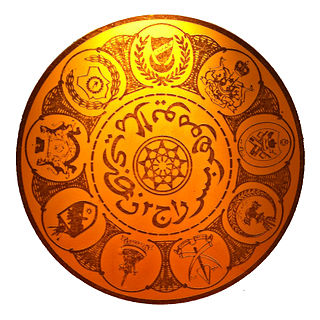
The monarchies of Malaysia refer to the constitutional monarchy system as practised in Malaysia. The political system of Malaysia is based on the Westminster parliamentary system in combination with features of a federation.
Tunku Alif Hussein Saifuddin Al-Amin ibni Tuanku Muhriz, was the third son of the reigning Yang di-Pertuan Besar of Negeri Sembilan, Tuanku Muhriz ibni Almarhum Tuanku Munawir.
Tuanku Antah ibni Almarhum Yamtuan Radin (1812–1888) was the sixth Yamtuan Besar of Negri Sembilan. He ruled from 1869 to 1888, and tried to keep Negri Sembilan independent from British rule. His son Tuanku Muhammad Shah succeeded him and modernised his state.